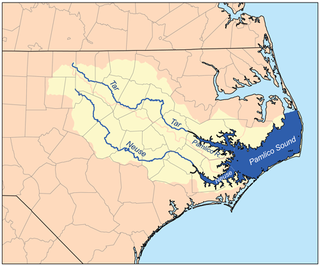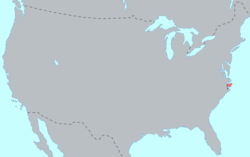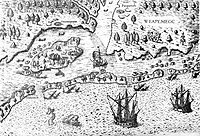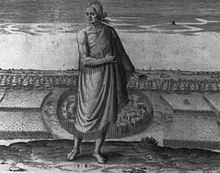
The Tuscarora are an Indigenous people of the Northeastern Woodlands in Canada and the United States. They are an Iroquoian Native American and First Nations people, based in New York and Ontario.

Roanoke Island is an island in Dare County, bordered by the Outer Banks of North Carolina. It was named after the historical Roanoke, a Carolina Algonquian people who inhabited the area in the 16th century at the time of English colonization.

The establishment of the Roanoke Colony was an attempt by Sir Walter Raleigh to found the first permanent English settlement in America. The colony was founded in 1585, but it was visited by a ship in 1590 and the crew found that the colonists had disappeared under unknown circumstances. It has come to be known as the Lost Colony, and the fate of the 112 to 121 colonists remains unknown to this day.

The Tuscarora War was fought in North Carolina from September 10, 1711, until February 11, 1715, between the Tuscarora people and their allies on one side and European American settlers, the Yamasee, and other allies on the other. This was considered the bloodiest colonial war in North Carolina. The Tuscarora signed a treaty with colonial officials in 1718 and settled on a reserved tract of land in Bertie County, North Carolina. The war incited further conflict on the part of the Tuscarora and led to changes in the slave trade of North and South Carolina.
John Lawson was an English explorer, naturalist and writer. He played an important role in exploring the interior of colonial North Carolina, South Carolina and Georgia, publicizing his expeditions in a book. He founded two settlements in North Carolina: Bath and New Bern, both located on rivers in the coastal plain. He was killed by Tuscarora people during the outbreak of the Tuscarora War.

The Meherrin people are an Indigenous people of the Northeastern Woodlands, who spoke an Iroquian language. They lived between the Piedmont and coastal plains at the border of Virginia and North Carolina.
The Coree were a very small Native American tribe, who once occupied a coastal area south of the Neuse River in southeastern North Carolina in the area now covered by Carteret and Craven counties. Early 20th-century scholars were unsure of what language they spoke, but the coastal areas were mostly populated by Iroquois and Algonquian peoples.
The Machapunga were a small Algonquian language–speaking Native American tribe from coastal northeastern North Carolina. They were part of the Secotan people. They were a group from the Powhatan Confederacy who migrated from present-day Virginia.

The PamlicoRiver is a tidal river that flows into Pamlico Sound, in North Carolina in the United States. It is formed by the confluence of the Tar River and Tranters Creek.

Waccamaw Siouan Indians are one of eight state-recognized tribes in North Carolina. They are also known as the "People of the Fallen Star." Historically Siouan-speaking, they are located predominantly in the southeastern North Carolina counties of Bladen and Columbus. Their congressional representative introduced a failed bill for federal recognition in 1948. North Carolina recognized the group in 1971.

The Croatan were a small Native American ethnic group living in the coastal areas of what is now North Carolina. They might have been a branch of the larger Roanoke people or allied with them.
Eleanor Dare of Westminster, London, England, was a member of the Roanoke Colony and the daughter of John White, the colony's governor. While little is known about her life, more is known about her than most of the sixteen other women who left England in 1587 as part of the Roanoke expedition.

The Chowanoc, also Chowanoke, are an Algonquian-speaking Native American tribe who historically lived near the Chowan River in North Carolina.

Manteo was a Croatan Native American, and was a member of the local tribe that befriended the English explorers who landed at Roanoke Island in 1584. Though many stories claim he was a chief, it is understood that his mother was actually the principal leader of the tribe. This leadership would not have automatically passed down to her children as many English at the time may have assumed.

Carolina Algonquian was an Algonquian language of the Eastern Algonquian subgroup formerly spoken in North Carolina, United States. Carolina Algonquian was formerly spoken by Secotan, Chowanoke and Weapemeoc peoples.

The Secotans were one of several groups of American Indians dominant in the Carolina sound region, between 1584 and 1590, with which English colonists had varying degrees of contact. Secotan villages included the Secotan, Aquascogoc, Dasamongueponke, Pomeiock (Pamlico) and Roanoac. Other local groups included the Chowanoke, Weapemeoc, Chesapeake, Ponouike, Neusiok, and Mangoak (Tuscarora), and all resided along the banks of the Albemarle and Pamlico sounds. They spoke Carolina Algonquian language, an Eastern Algonquian language.

The Aquascogoc is the name given to a Native American tribe of Secotan people and also the name of a village encountered by English colonists during their late 16th century attempts to settle and establish permanent colonies in what is now North Carolina, known at the time as Virginia. Together with the rest of Secotan people they formed a part of the Native American group known as the Carolina Algonquian Indians, and spoke the now extinct Carolina Algonquian language. In 1585 the village of Aquascogoc was burned by Sir Richard Grenville, in retaliation for the alleged theft of a silver drinking vessel.
Woccon was one of two Catawban languages of what is now the Eastern United States. Together with the Western Siouan languages, they formed the Siouan language family. It is attested only in a vocabulary of 143 words, printed in a 1709 compilation by English colonist John Lawson of Carolina. The Woccon people that Lawson encountered have been considered by scholars to have been a late subdivision of the Waccamaw.
The Hatteras Indians were a tribe of Native Americans in the United States who lived in the North Carolina Outer Banks. They inhabited a village on what is now called Hatteras Island called Croatoan.
Tom Blount was a Tuscarora chief best known for his role in the Tuscarora War. During the conflict, he allied with the British colonies of North Carolina and South Carolina. He and his allies in the northern band of the Tuscarora fought alongside British colonists against the southern band after Blount was promised full control over the Tuscarora and a permanent alliance with the British if they did so. In 1712, Blount was able to capture southern Tuscarora chief Hancock, who was executed by the colonists. This would ultimately lead to the demise of the southern Tuscarora. In 1713, Blount's band had all but secured victory. Members of the southern band began to move north to New York and joined the Iroquois tribe. There would still be small skirmishes and raids until 1715.

















